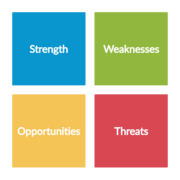TeamSted
Hashimhameed (Talk | contribs) (→Tool 1 - SWOT) |
Hashimhameed (Talk | contribs) (→Tool 1 - SWOT) |
||
| Line 38: | Line 38: | ||
===Tool 1 - SWOT === | ===Tool 1 - SWOT === | ||
| − | SWOT is a framework used for identifying and analyzing the strength, weakness, opportunities and threats within a company. The model is divided into internal factors (strength and weakness) and external factors (opportunities and threats). Each of the four elements provides insight of the strategical level within a company: | + | SWOT is a framework used for identifying and analyzing the strength, weakness, opportunities and threats within a company. The model is divided into internal factors (strength and weakness) and external factors (opportunities and threats). Each of the four elements provides insight of the strategical level within a company......: |
| − | * Strength: The first element highlights the strength within a company and investigates how they distinguish from competitors. | + | * ===Strength===: |
| − | * Weakness: This second element highlights the weakness within a company, and critically investigates what other companies do better. | + | The first element highlights the strength within a company and investigates how they distinguish from competitors. |
| − | * Opportunities: The third element highlights the opportunities within a company, and looks into the company development of new ideas that lead to new markets | + | * ===Weakness===: |
| − | * Threats: The fourth element highlights the threats within a company, and investigates what may affect the success/growth of | + | This second element highlights the weakness within a company, and critically investigates what other companies do better. |
| + | * ===Opportunities===: | ||
| + | The third element highlights the opportunities within a company, and looks into the company development of new ideas that lead to new markets | ||
| + | * ===Threats===: | ||
| + | The fourth element highlights the threats within a company, and investigates what may affect the success/growth of a company | ||
[[File:TeamSted-SWOT.png|thumb|Figure 1: SWOT model - Made by TeamSted]] | [[File:TeamSted-SWOT.png|thumb|Figure 1: SWOT model - Made by TeamSted]] | ||
Revision as of 14:53, 23 February 2020
Work in progress!!! This article will contain a reporting on relevant tools related to case work conducted together with Ørsted.
And remember boyzzz, we draw all the figures ourself. If you are not good at it, draw a draft and it will be revised.
| Erik Arvid | Hosszu | s200154 |
| Jacob | Clemmensen | s144069 |
| Björgvin | Hjartarson | s154659 |
| Breno | Strüssmann | s193580 |
| Tobias | Thyssen | s143786 |
| Hashim | Harmeed | s193272 |
Contents |
Introduction
Tools
Introduce the tools chosen and why they were chosen (importance). Also relevance to the specific case
Tool 1 - SWOT
SWOT is a framework used for identifying and analyzing the strength, weakness, opportunities and threats within a company. The model is divided into internal factors (strength and weakness) and external factors (opportunities and threats). Each of the four elements provides insight of the strategical level within a company......:
- ===Strength===:
The first element highlights the strength within a company and investigates how they distinguish from competitors.
- ===Weakness===:
This second element highlights the weakness within a company, and critically investigates what other companies do better.
- ===Opportunities===:
The third element highlights the opportunities within a company, and looks into the company development of new ideas that lead to new markets
- ===Threats===:
The fourth element highlights the threats within a company, and investigates what may affect the success/growth of a company
